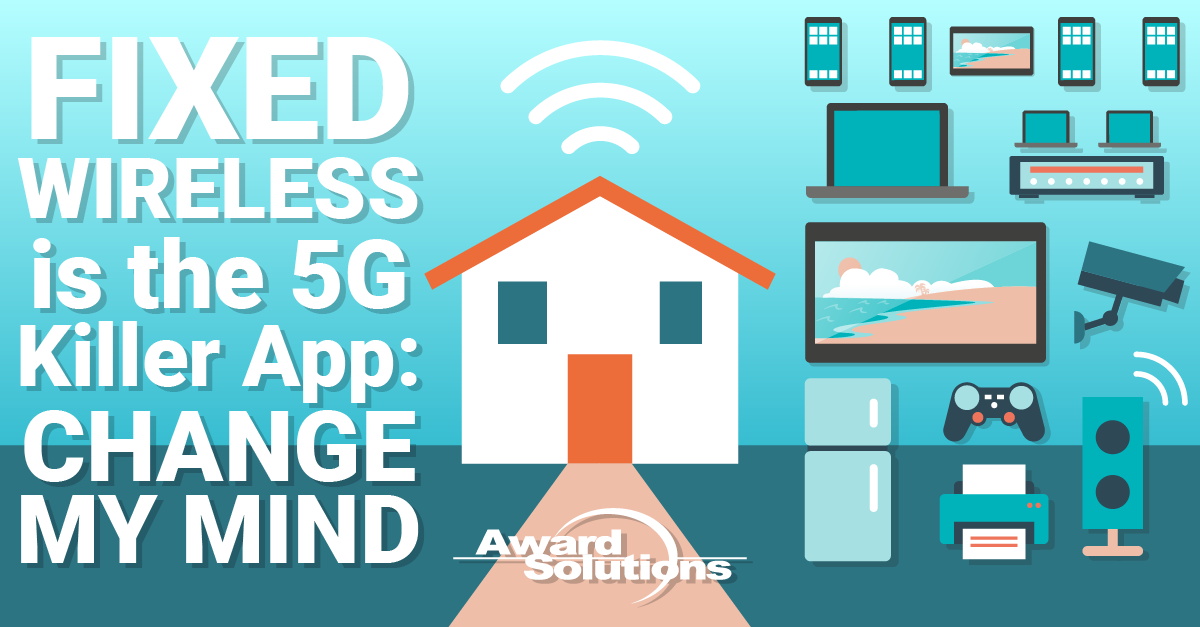
5G use cases like autonomous vehicles, virtual or augmented reality, remote surgery, network slicing, and smart factories get all the love. But let’s not miss the killer app that already exists – Fixed Wireless Access (FWA).
Many of these shiny use cases require advanced implementations of 5G leveraging features available in Release 16 (lower latency, higher reliability) and Release 17. However, first-generation 5G networks using mid-band spectrum like C-Band and millimeter wave (mmWave) provide increased capacity, making 5G an attractive network for FWA.
Quick Background
In its recommendation released in September of 2015 (ITU-R M.2083-0) titled “IMT Vision – Framework and overall objectives of the future development of IMT for 2020 and beyond” the International Telecommunication Union (ITU) defined three usage scenarios for 5G:
1. Enhanced Mobile Broadband (eMBB)
2. Massive Machine Type Connectivity (mMTC)
3. Ultra-Reliable Low Latency Communications (URLLC)
First-generation 5G networks (Release 15 Non-Standalone (NSA)) primarily enable the eMBB usage scenario by leveraging more spectrum. Mid-band spectrums like C-Band and millimeter wave provide increased capacity due to the amount of spectrum available. This capacity is important for Fixed Wireless Access.
Fixed Wireless Access and Decaf Coffee
Is fixed wireless an oxymoron? We developed wireless to provide mobility. It reminds me of decaf coffee. Coffee is for caffeine, right? Is decaf coffee an oxymoron? No, people enjoy it with dessert or for something warm on a cold day. The same is true for fixed wireless. There are more benefits to wireless than just mobility. Please keep reading despite your emotions toward decaf coffee.
Drivers for Fixed Wireless Access
Fiber and coax provide a solid home broadband experience with high capacity and peak speeds. So why would Fixed Wireless Access even be considered?
The three key drivers of Fixed Wireless Access:
1. Cost: The first and most obvious is the cost to run fiber or cable past the homes. With an average price of $40-$60k per mile to install, fiber requires a heft upfront investment.
2. Speed to Market: With an existing wireless network, you can immediately begin to offer fixed wireless access to a subset of users and gauge the level of interest with very little investment. If the opportunity grows, you can invest more into the solution to reach a larger market.
3. Ease of Deployment: You can ship the equipment to the home, and they can plug it in, turn it on, and get service in minutes. Some solutions may still require a truck roll, but those requirements are decreasing.
These drivers and more make fixed wireless access the killer app of 5G. The rural opportunity is enormous, and government funding is available through the Rural Digital Opportunity Fund (RDOF).
The Need for Speed
I am surprised by the speeds available from fiber and coax, not because they are awesome but because they are over the top. For example, if you have four 4K TVs running simultaneously, four full high definition (FHD) cameras taking live video, and other IoT solutions, you only need 100 Mbps.
See the Netflix recommendations here and the math below:
- Four 4K TVs * 15Mbps = 60Mbps.
- Four FHD cameras at 5 Mbps = 20 Mbps
- 20 Mbps for other IoT solutions
5G, with 100 Mbps speeds, will handle over 99% of the consumer market.
Market
USCC has partnered with Ericsson to push the limits of mmWave coverage to over 5 Km. Learn more about how here. They launched FWA using mmWave in Q2 2022, and although they have a relatively small base, it is rapidly growing.
In a recent Fierce Wireless article, Hans Vestberg, Verizon CEO, said, “It took us 22 years to pass 17 million households with fiber. 22 years. That’s how hard it is,” Vestberg said, “We basically had 30 million households covered with fixed wireless access in less than one year.” Verizon’s net adds in FWA are also increasing rapidly.
T-Mobile has added 2 million high-speed Internet customers in their first full year since their commercial launch, and CEO Michael Sievert has some things to say about it here. Even private equity firms are investing in fixed wireless broadband.
Conclusion
Even though a fixed wireless access service is relatively dull, to date, it is undoubtedly the killer use case for 5G. FWA benefits from the increased capacity of the mid-band and millimeter wave spectrum. It may taper off and give way to other killer apps appearing late this year. But, for now, FWA is 5G’s killer use case. Do you agree? Let’s drink a cup of decaf coffee (caffeinated, if you prefer) and talk about it.
